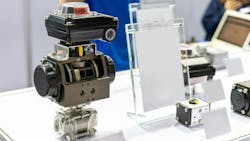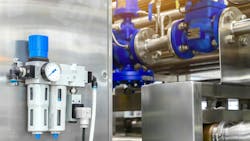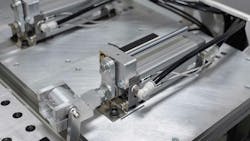Industrial Pneumatics: Operational Essentials and Specification Tips
What you’ll learn:
- How pneumatic actuators compare with electric actuators.
- Tips for selecting the right pneumatic actuator technology.
- Industrial applications in which pneumatic systems are commonly used.
In order to remain competitive, industrial organizations of all kinds are being challenged to improve operating efficiencies, performance, and productivity — especially by preventing downtime. Embracing automation is an effective across-the-board solution.
The continued proliferation of industrial automation technologies in industries extending from automotive, food and beverage, and equipment manufacturing to oil and gas exploration and refinement is driving steady growth in the global pneumatic actuators market, which was valued at $54.37 billion in 2024 and is projected to grow to a value of $73.83 billion by 2030.
Pneumatic systems are a relatively clean and nonhazardous way to move energy throughout industrial facilities, and it’s very easy to move air throughout a facility. You only need one compressor to move air throughout plants and warehouses extending from several hundred thousand to close to a million square feet.
And since air is a clean energy source, any leakage out into the facility isn’t dangerous — unlike leakage from competing motion technologies, such as fluid, pressure, or steam. Your system wouldn’t be quite as efficient as it could be, sure, but small leaks in pneumatic air lines don’t really hurt anything.
In this article, author Mark Russell, the technical application support manager at RS in the Americas, provides a deep dive into industrial pneumatics by offering insights into the essentials of how they work, best practices for selecting pneumatic actuators and common uses in industrial applications.
Pneumatic vs. Electric Actuators: The Similarities and Differences Between Each Technology
Pneumatic actuators are a lot like electric actuators. Both convert an energy source into mechanical motion to move and reposition objects over short distances, typically just two or three feet, and both are rugged, reliable, and durable enough for use in harsh industrial environments.
Both actuator technologies also enable linear or rotational movement via a piston that extends and retracts or a shaft that, like any other motor, rotates somewhere between zero and 360 degrees in one direction or the other, but not continuously.
Rotary actuators provide a single rotation (e.g., 90 degrees forward and then 90 degrees back), like a rotary phone, but with the extension and retraction enabled by compressed air rather than a spring. Linear actuators typically provide a single point of linear or rotational extension and retraction but also enable linear slides, which are rail assemblies that extend and retract a whole platform. These are typically used to move whole assemblies instead of just single objects.
The biggest differences between pneumatic and electric actuators are their energy source — compressed air versus electricity — their speed, and their positioning capabilities.
While electric actuators convert electricity into mechanical motion, pneumatic actuators convert air. When compressed air moves into a pneumatic actuator it exerts pressure, and since there’s atmospheric air on the other side of the actuator, putting extra pressure on one side of the actuator causes it to move into its extended state. For the same reason, removing the compressed air pressure generates a spring return back to where you started.
Pneumatic actuators are also very fast. In fact, pneumatic actuators outperform most other motion technologies — including electric, hydraulic, and steam-powered devices — in small-distance manipulation applications because they can move large loads very quickly.
What they’re not quite as good at is positioning. Pneumatic actuators are designed to move between their fully extended and fully retracted states. So, if your application requires that you stop somewhere in the middle of the stroke, electric actuators have an edge.
How to Select the Right Pneumatic Actuator for Your Industrial Application
If you’re looking to utilize pneumatic actuation, you’re either looking to move an object or change its orientation. Once you identify what type of motion or manipulation you require, you need to identify the amount of force required to affect that change at the appropriate intervals.
And since there are a lot of different ways to achieve linear movement, you also need to identify the overall profile of the desired motion. Is it a simple redirection or a full transition? The answers to these questions will help determine which pneumatic actuator is right for you.
One of the most important things to avoid when selecting a pneumatic actuator is buying one with more power than you need. If the actuator doesn’t know that you’re only moving 4 lbs. when it can move 40, it’s going to use the same amount of air. So, right sizing your actuators helps improve overall efficiency.
The biggest source of wasted energy in industrial facilities that utilize pneumatics is typically the air compressor — and not because air compressors are inherently inefficient, but because too many people oversize too many pneumatic components and tend to overlook minor maintenance issues since pneumatic systems are so robust and typically continue to work anyway, just a bit less efficiently.
Prioritizing pneumatic actuators with IIoT (Industrial Internet of Things) capabilities, like support for the IO-Link communication protocol, enables seamless communication and control — especially in hybrid motion control systems — and further improves efficiency. Smart pneumatic actuators can directly communicate with valve banks, manifolds, and other motion technologies.
Pneumatic actuators don’t have as many common certifications as electric actuators. For example, they aren’t UL certified since they’re not a fire hazard. There are some efficiency certifications that can help you identify more efficient models, which is ideal if you’re working in a very lean environment such as a mobile application that doesn’t have a compressor built in but is instead working off of stored air and could benefit from higher efficiency performance. There are also ATEX-certified explosion-proof models for especially extreme environments.
Additionally, once you’ve selected your pneumatic actuator, it’s essential to ensure that you also acquire the right piping, fittings, and air prep assemblies.
These decisions can feel daunting too. But application engineers at experienced suppliers and distributors will be happy to help you figure out what pneumatic actuator is best for you and identify all the components and devices you need to integrate the actuator into your process and execute the task at hand.
When evaluating pneumatic suppliers, prioritize those that offer all the accessories you need to integrate their products into your system — or better yet, offer customized end-to-end system solutions. For pneumatic actuators, you’ll also need fittings to attach them to your compressed air lines, tubing to connect the actuators to the air supply, manifolds to distribute air to various devices, and valves to control the airflow.
While most of these components are relatively universal and interchangeable, buying all of your pneumatic products from a single supplier provides you with a single bill of materials (BOM) and ensures that all the fittings are the same which simplifies procurement, installation, and maintenance.
Common Implementation Challenges with Pneumatics
The biggest challenge when looking at anything from a pneumatics point of view is figuring out the full scope of where pneumatics will be used. Pneumatics are a lot like plumbing, and if you want to add a bathroom to your house, it's not as easy as just putting a toilet somewhere. There’s a lot more planning that has to go into it.
When you’re adding a new electrical device to an industrial facility, you can just run some power to it and be ready to go. But if you want to use pneumatics, you need to be able to run air to it and to filter, regulate, and maybe even clean that air, depending on the application. You also need to decide how much compressed air the new device will consume, which is usually a variable rate, and plan for that to ensure that your supply meets your total demand. Pneumatics require a lot more forethought and setup to ensure success.
It can also be challenging to know when to quit trying to use air and switch to an alternative solution. Say at some point that you need to move an object into three positions. Should you use three different pneumatic actuators to do that, or should you use just one electric or hydraulic actuator? Just because you're starting with air doesn't mean that you can't go air to electrical and then back to air for different parts of your process. You can! In fact, hybrid systems that combine pneumatic, electric, and even hydraulic motion technologies are extremely common in industrial facilities. They all have their comparative benefits, and they all work well together. You can even control them all using the same control platform.
It’s important to identify which part of your processes are best suited for pneumatics and which parts are best suited for other motion technologies. And positioning capabilities aren’t the only deciding factor. You also have to consider maintenance requirements and user interactions.
For example, it’s often best to avoid user interaction with industrial pneumatics since compressed air is stored energy. So, when you turn it off, there’s still air present until you do something to get rid of it. As such, if the application is something that users will interact with often, pneumatics may not be your best bet.
If you’re switching from electric to pneumatic actuation, you already have a really good idea of what your scope is and should be able to easily see which parts of your process are well-suited to switch, which makes implementation a little easier than starting from scratch with pneumatics. The biggest challenge in this instance is making sure that you have a good, reliable air source everywhere you’re going.
And while starting from scratch with pneumatics does require more forethought and setup, you don’t have to do it alone. Application engineers at experienced pneumatics suppliers and distributors can help you through the evaluation, decision, procurement, and integration processes to ensure success.
Pneumatic Actuators Benefit Numerous Applications
Pneumatic actuators are engineered for speed, ease of maintenance, and moving very large loads. So, they’re great for industrial manufacturing, material handling and packaging, warehousing, and distribution applications. These can include positioning objects, transferring objects between adjacent conveyors, and rotating objects into new orientations — for instance, to support large and/or complex assemblies.
They’re also widely used for repetitive tasks, like building, sorting, labelling, and positioning things on manufacturing and packaging lines. For example, most of the box erectors in industrial packaging lines and sorting systems in warehousing and distribution applications use pneumatic actuators because time is money, and they’re so fast.
Bottling lines are another good example. Pneumatic actuators are widely used to cap beer, soda, and medicine bottles with a quick press or rotation, and they’re especially well-suited for use in food and beverage and pharmaceutical applications due to how clean and safe they are.
Pneumatics can also be used to manipulate objects with a puff of air instead of a physical extension or rotation. This application is very common in sortation systems. For instance, blueberries or beans coming in from the field go through a washing system to remove dirt and an inspection system to remove any mealy berries, broken beans, or inedible debris such as rocks that got caught up in the harvester.
The inspection systems use little puffs of air to blow undesirable items off the line into a scrap container. The food still has to be inspected by a human further down the line, but the inspection system makes that a much more efficient process.
Pneumatics is a very old technology. It’s been around a long time and is well integrated into most industrial market segments, including oil and gas extraction and refinement, equipment, automotive, aerospace, food and beverage, and pharmaceutical manufacturing, material handling and packaging, warehousing, and distribution. So, the applications are pretty well ingrained, and all of them extend or rotate something over a short distance.
We are seeing pneumatics become more accessible on a smaller scale in some instances, as well. For example, pneumatic tools are becoming more popular in panel building and other small, local manufacturing operations due to how much faster they are than electrical tools. In addition to boosting production speed and efficiency, pneumatic tools don’t have any battery packs that you have to charge, and they’re a lot lighter than most electrical tools.
In closing, when choosing to use pneumatics for your industrial application, be sure to pay attention to your overall air consumption demands, right-size your pneumatic components, and work with trusted suppliers who have the knowledge, experience, and extensive product portfolios needed to ensure application success.
Customers commonly get frustrated with their air supply and airflow because they’re demanding more air than physically fits through their delivery system. They’ve often got valves which aren’t articulating properly because they’ve got several other valves articulating at the same time and choking them out.
Working with an application engineering team at a partner supplier can help ensure that both your air and budget is well maintained throughout your system. The same is true for your energy and monetary budgets. It can be very tempting when you’re building a system to just go, “Yep, that’ll work,” and move on instead of optimizing down to your minimum requirements for maximum energy and economic efficiency.
Going with a cylinder that can manage 100 lb. loads but will only ever be tasked with 10 lb. loads means that you’ll consume about 10 times the amount of air to make that cylinder do its job. And to pull that much more air in, you’ll need to upsize your supply tubing, regulator, filter, compressor, and storage tanks. So, you can lose a lot of money that way in addition to overloading your supply system.
But an industry partner like RS can help you dive into the specifics of your application and utilize a combination of tested and proven equations and advanced digital technologies to calculate individual system needs in order to design and optimize efficient, reliable pneumatic systems delivering exactly that.
This article was written and contributed by Mark Russell, technical application support manager at RS in the Americas.
About the Author

Mark Russell
Technical Application Support Manager, RS
Mark Russell is the technical application support manager – Americas at RS, a high-service global product and service solutions provider for industrial customers. He and his skilled team of application engineers leverage their collective expertise and the advanced facilities at the company’s North American headquarters in Fort Worth, TX, to demonstrate how RS products integrate into and improve new and existing industrial systems. They also help customers identify the right products for their unique application and operating environment and ensure that they get the most out of every product they purchase from RS.
In the Americas region, RS stocks over 250,000 industrial and electronic products from more than 700 suppliers covering categories extending from automation and control equipment to interconnect, passive, active, and electromechanical components.

Leaders relevant to this article:





